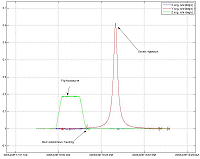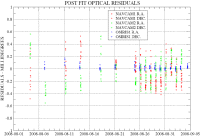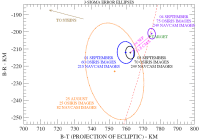No. 104 - Asteroid Steins Flyby
The navigation images from the last navigation slot on 4 September 2008, after the TCM, confirmed that the spacecraft was well on track for the asteroid encounter. The fly-by was conducted successfully and as expected, with the spacecraft autonomously tracking asteroid Steins. No single error event was reported by the spacecraft in the reporting period. A detailed analysis of the spacecraft performance is being conducted with the data recorded on-board.
The bulk of the scientific operations was conducted in the hours around the encounter (see also the links in the right-hand menu, for the first images and results).
Mission operations were conducted with the support of the ESA New Norcia (NNO) and Cebreros (CEB) ground stations and with NASA DSN ground stations (DSS).
| DOY | Date | Pass | Main Activity |
| 243 | 30/08/08 | NNO 1646 DSS-54 1647 |
Navigation slot 12 Monitoring |
| 244 | 31/08/08 | NNO 1647 DSS-54 1648 |
Navigation slot 13 |
| 245 | 01/09/08 | NNO 1648 DSS-25 1649 |
Navigation slot 14 Monitoring |
| 246 | 02/09/08 | NNO 1649 DSS-54 1650 DSS-24 1650 |
Navigation slot 15 Monitoring (pass deleted) Monitoring |
| 247 | 03/09/08 | NNO 1650 DSS-24 1651 |
Navigation slot 16 Monitoring |
| 248 | 04/09/08 | NNO 1651 CEB 1316 |
TCM at CA-36 hours Navigation slot 17 |
| 249 | 05/09/08 | DSS-24 1652 NNO 1652 DSS-45 1652 CEB 1317 DSS-15 1653 |
Monitoring |
At the end of the reporting period (DoY 249) Rosetta was at 358.9 million km from Earth (2.39 AU) and the one-way signal travel time was 1197 seconds. The distance to the Sun was 319.2 million km (2.13 AU).
Asteroid Steins Fly-by
 |
|
Figure 1. Spacecraft attitude angle rates during flip manoeuvre and asteroid Steins fly-by. |
Just before closest approach, Rosetta entered in asteroid fly-by mode (AFM) in which the attitude of the spacecraft is automatically driven by an on-board navigation camera. This mode was rehearsed in March this year and has continuously kept asteroid Steins in the field of view of Rosetta's imaging instruments, while the spacecraft flew past the asteroid at a relative speed of 8.6 kms-1. Figure 1 shows the angle rates for the spacecraft's three main axes between about 17:44 and 19:14 UT on 5 September 2008.
 |
|
Figure 2. Schematic diagram illustrating the manoeuvres during the asteroid fly-by, with time running from left to right and the spacecraft's attitude indicated by its +Z axis (toward position of asteroid Steins - red marker) and +X axis (blue). The actual measured rotation rates about the Z axis (green) and the Y axis (red) during the 5 September fly-by are given in Figure 1. |
The following table is a simplified version of the operations timeline that characterised the fly-by, listing the main events leading up to closest approach and main events afterward until end of pointing.
| 4 September 2008 (DoY 248) | |
| Time* | Event/Activity |
| 05:00 s | Start TCM/reaction wheel off-loading slot (CA-36 hours) |
| 09:00 s | End TCM/reaction wheel off-loading slot (CA-36 hours) |
| 11:00 s | Start last image acquisition for navigation (slot #17) |
| 16:00 s | Last image acquisition for navigation (slot #17) |
| 5 September 2008 (DoY 249) | |
| 06:20 g | Start navigation camera (NAVCAM) asteroid tracking attempts |
| 09:00 g | Uplink of updated fly-by commands |
| 14:20 g | Final settings for NAVCAM defined |
| 15:00 g | GO decision for asteroid fly-by mode (AFM) taken |
| 16:00 g | NAVCAM A selected for AFM, final telecommands uplinked |
| 17:58 s | Start spacecraft attitude flip manoeuvre |
| 18:18 s | End spacecraft attitude flip manoeuvre |
| 18:19 s | Start asteroid closed loop tracking (autonomous tracking) |
| 18:28 s | High-gain antenna stops tracking the Earth - loss of telemetry signal |
| 18:30 s | Fault detection, isolation and recovery (FDIR) disabled on-board |
| 18:36 s | Phase angle zero crossing |
| 18:38 s |
Closest approach (CA) |
| 19:38 s | End of asteroid closed loop tracking |
| 19:48 s | Fault detection, isolation and recovery (FDIR) re-enabled on-board |
| 19:54 s | High-gain antenna resumes tracking the Earth (acquisition of telemetry signal on the ground) |
| 23:20 g | Start science data downlink |
| 7 September 2008 (DoY 251) | |
| 14:00 s | Planned end of pointing |
*All times are in UT. An 's' or 'g' after the time indicates an event at the spacecraft or on ground respectively. The one-way light time was about 20 minutes for these dates.
To monitor the spacecraft status after the fly-by, the Cebreros tracking of DoY 249 was extended beyond the planned time with the antenna following the spacecraft below 10° elevation. This action allowed the operations team to confirm successful fly-by as soon as the telemetry was received at 20:14 UT (ground time).
Trajectory Control Manoeuvre (CA-36 hours)
A final trajectory control manoeuvre was performed on DoY 248, around 36 hours before closest approach to asteroid Steins:
| Closest Approach-36 hours TCM | |
| Date |
4 September 2008 |
| Start of burn |
07:26 UT |
| Length of burn |
103.5 s |
| Fuel consumption |
127.10 g |
|
delta-V |
11.8 (cms-1) |
|
CA distance before TCM |
791.4 km |
|
CA distance after TCM |
800.7 km |
The delta-V of the TCM adjusted Rosetta's trajectory such that the estimated distance of the spacecraft relative to Steins at closest approach shifted from 791.4 km to 800.7 km (see Figure 2 below). The target distance was 800 km, which is set by the fly-by conditions to be compatible with spacecraft performance.
To help determine the required delta-V of the TCM, images of the asteroid gathered by both the two navigation cameras (NAVCAM A & B) and the OSIRIS instrument, as part of the optical navigation campaign, were used.
Optical Navigation Campaign
The optical navigation campaign started 4 August. Images were taken twice a week up to 25 August, from which date onward images were taken daily up to and including 4 September 2008. This reporting period covers the last six navigation slots (no. 12 / no. 17).
The post fit statistics of the data from all the images acquired by the NAVCAMs and OSIRIS is listed in the table below, separately for the right ascension and declination determination. It includes the observations from all seventeen navigation slot dates between 4 August and 4 September inclusive. (Note, only the NAVCAM images from 4 September are not yet included).
Stated for the three cameras are: the total number of images obtained on these seventeen days, the mean residual of the data to the last solution, and both the root mean square and standard deviation of the residuals.
| Optical Navigation post fit statistics (residuals in millidegrees relative to solution) | ||||
|
Right Ascension | ||||
| camera |
No. |
mean | root mean sq. | standard dev. |
| NAVCAM A |
121 |
-0.108 |
0.203 |
0.172 |
| NAVCAM B |
128 |
-0.036 |
0.194 |
0.191 |
| OSIRIS |
75 |
0.013 |
0.035 |
0.032 |
| ALL |
324 |
-0.052 |
0.175 |
0.167 |
|
Declination | ||||
| NAVCAM A |
121 |
-0.001 |
0.219 |
0.219 |
| NAVCAM B |
128 |
-0.067 |
0.241 |
0.232 |
| OSIRIS |
75 |
0.033 |
0.048 |
0.034 |
| ALL |
324 |
-0.019 |
0.204 |
0.203 |
Figure 3 shows a plot of the post fit residuals (right ascension and declination) for all images obtained by the three cameras on all seventeen navigation slot dates (excluding the NAVCAM images from 4 September).
Figure 4 shows the situation in the asteroid Steins fly-by target plane as it evolved between 25 August and 4 September, including the effect of the TCM on Rosetta's fly-by distance.
Spacecraft
The spacecraft behaved very well during the asteroid fly-by and no single parameter indicated a problem. Detailed analysis of the dynamic behaviour of the spacecraft will now be performed once all the data are available.
Payload
Most of the instruments have been activated as part of the fly-by campaign:
ALICE
The instrument was active during the fly-by and operations were conducted according to the plan.
CONSERT
The instrument is OFF.
COSIMA
The instrument is OFF.
GIADA
The instrument was active during the fly-by and operations were conducted according to the plan.
MIDAS
The instrument is OFF.
MIRO
The instrument was active during the fly-by and operations were conducted according to the plan.
OSIRIS
The instrument was extensively used as part of the navigation campaign required for the approach to Steins. The last images for this activity were taken on DoY 248 between 11:00 and 13:00 UT. These images allowed the mission control team at ESOC to assess the final targeting before the fly-by the next day.
The instrument was later operated as part of the fly-by operations. Both cameras (narrow-angle and wide-angle) have been operating during the fly-by, with the NAC autonomously switching to safe mode at about 9 minutes before closest approach. The PI team could deliver shortly after the fly-by astonishing images taken with the WAC. After the successful fly-by, the instrument remained active for the gravitational microlensing event observation.
ROSINA
The instrument was active during the fly-by and operations were conducted according to the plan.
RPC
The instrument was active during the fly-by and operations were conducted according to the plan.
RSI
The instrument is muted.
VIRTIS
The instrument was active during the fly-by and operations were conducted according to the plan.
LANDER Philae
The instrument was active during the fly-by and operations were conducted according to the plan.
SREM
Since DoY 184/2008 the accumulation settings are configured for active cruise mode.
Future Milestones
The fly-by operations will continue now for a few days with gravitational microlensing observations using the OSIRIS instrument. The data downlink phase will last until the beginning of October, interleaved with OSIRIS science observations. The spacecraft will then continue its 4th orbit around the Sun reaching aphelion on 17 December 2008 at a distance of 2.26 AU to head back to the Earth for the mission's third and last Earth swing-by on 13 November 2009.
---
Legal disclaimer
This report is based on the ESOC mission operations report, WOR #104. Please see the copyright section of the legal disclaimer (bottom of this page) for terms of use.




